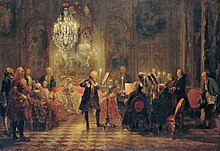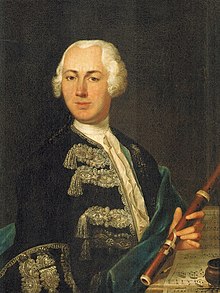Johann Joachim Quantz
Johann Joachim Quantz (born January 30, 1697 in Scheden , Electorate Braunschweig-Lüneburg as Hanß Jochim Quantz; † July 12, 1773 in Potsdam ) was a German flautist , flute maker, composer and flute teacher of Frederick the Great . His contemporaries also wrote it Quanz .
Life
Quantz was born as the fifth child of the farrier Andreas Quantz in Oberscheden in the newly formed Electorate of Braunschweig-Lüneburg. After the death of his parents (1702 and 1707) his uncle Justus Quantz, who was town musician in Merseburg , and the husband of his cousin, the organist Johann Friedrich Kiesewetter, took over the training. The uncle soon also died and Quantz received further training from his successor, Johann Adolf Fleischhack. During this time, Quantz played on a temporary basis in the court orchestra of Prince Friedrich Erdmann of Saxony-Merseburg . When he died on June 2, 1714, a three-month court mourning was imposed, during which the court musicians were also without income. Quantz then went on foot from Merseburg to Dresden and applied there in June 1714 for a position as a city piper . However, he did not succeed, so at the end of June 1714 he moved on to the neighboring town of Radeberg and was employed there as a journeyman piper. When Radeberg was almost completely destroyed during the city fire on July 13-14, 1714 and Quantz's musician position was canceled after only three weeks of service, he moved to Pirna the day after the fire and became the city piper there in 1714. In his further training as a town piper he learned violin , oboe , trumpet , zinc , french horn , trombone , recorder , bassoon , violoncello , viol and double bass . After completing his training, in March 1716 he got a job in the Dresden City Orchestra (oboe and flute). After two years in the service of the town musician there, he switched to the Polish orchestra of August II as an oboist , with whom he regularly traveled to Poland.
In order to advance professionally, he studied with Jan Dismas Zelenka and Johann Joseph Fux in Vienna in 1717 ; the following year he took flute lessons from the French flautist Pierre-Gabriel Buffardin in Dresden and began to compose. A study trip took him to Italy from 1724 to 1726, where he studied counterpoint with Francesco Gasparini , the concertmaster of the Lateran in Rome, met Alessandro Scarlatti in Naples , made friends with the castrato Farinelli and heard his musical role model Antonio Vivaldi in Venice . From 1726 to 1727 he stayed in Paris and London , where George Frideric Handel urged him to stay in England. Through these trips he came into contact with the emerging pre-classical music .
In 1728 he became a flautist with the Electoral Saxon and Royal Polish Chapel in Dresden and got to know the then Prussian Crown Prince Friedrich, who from then on gave flute lessons, which the Soldier King forbade immediately. Quantz himself told Nicolai how he once had to hide in the closet during one of Friedrich's father's controls. In 1737, Quantz married Anna Rosina Carolina Schindler. As Marpurg reports, she took his marriage vows from him on his deathbed, only to recover immediately - the marriage was not very happy, it was common knowledge in Berlin that she bullied her husband. After Friedrich became king, in 1741 he offered Quantz such favorable conditions if he would become his chamber musician and court composer that Quantz accepted. At the Prussian court in Berlin and Potsdam he gave Friedrich daily lessons, conducted house concerts and composed. He enjoyed the privilege of being able to criticize the king's game and at times accompanied him to the camp. He also built flutes himself, improved them by adding the second key, and in 1752 wrote the flute textbook Attempting an Instruction to Play the Flute Traversiere (the traverse flute had also established itself in the French style ).

Quantz stayed at Friedrich's court until his death. In 1755 an autobiography appeared in the historically critical contributions to the recording of the music by Friedrich Wilhelm Marpurg; another followed in Italian in 1762 , and his great-nephew Albert Quantz paid special tribute to him in 1877.
The king had Quantz's grave in Potsdam decorated with sculptures by the Räntz brothers. He was initially buried in the suburb of Nauen and was reburied in the old cemetery (Heinrich-Mann-Allee) in the suburb of Teltow in 1865 ; his grave there was completely renovated in 1994.
Most of the Quantz compositions are intended for the flute. These include more than 200 flute solo sonatas, around 300 flute concertos , 45 trio sonatas and 9 horn concertos .
Flute duos, trios and quartets are also passed down, and in addition to songs, the New Church Melodies ... (chorale melodies to 22 odes by Gellert from 1760).
Most of the works are only available as manuscripts , as very few pieces have appeared in print . Concerts with Quantz's works take place regularly in Scheden, his birthplace. His textbook attempt at an instruction to play the flute traversière (1752) is much more than a flute school. Rather, it conveys a comprehensive picture of the performance practice and musical aesthetics of the late late baroque. It was re-edited in 1992 in Munich & Kassel. In a criticism he replied in Marpurg "contributions" in 1755 with Application pour la flûte traversière à deux clefs, o. J.
Fonts
- Johann Joachim Quantzens, Royal. Prussian Chamber Music, attempt at an instruction to play the flute traversate: accompanied with various notes useful to promote good taste in practical music, and explained with examples, along with XXIV copper plates. Berlin, JF Voss 1752 (first edition). Third edition. Breslau, 1789. at Johann Friedrich Korn the Elder, in the bookstore next to the K. Ober- Zoll- und Accisamte on the large ring (Bärenreiter published a reprint of this 3rd and last German edition of the 18th century in 1953). ( Wikisource ; archive.org )
- Autobiographical abstract , first in Marpurg's contributions in 1755; Reprinted in: Kahl (Ed.) Self-biographies of German musicians of the 18th century . Cologne 1948, Amsterdam 1972

See also
literature
chronologically
- Albert Quantz: Life and work of the flutist JJQuantz . Berlin 1877
- Robert Eitner: Quantz, Johann Joachim . In: Allgemeine Deutsche Biographie (ADB). Volume 27, Duncker & Humblot, Leipzig 1888, pp. 15-25.
- Adolf Raskin : Quantz - his life and his compositions . Dissertation, Cologne, 1923 (typescript, 166 pages). Open Access available via ViFaMusik
- Ingeborg Allihn: Georg Philipp Telemann and Johann Joachim Quantz . Magdeburg 1971
- Meike ten Brink: The Flute Concerts by Johann Joachim Quantz . Goettingen 1995
- Horst Augsbach: Thematic-systematic catalog raisonné (QV) Johann Joachim Quantz . Carus, Stuttgart 1997
- Ingeborg Langer: How was the king of the village blacksmith's son a teacher . Merseburg 1997
- Mary Oleskiewicz: “Johann Joachim Quantz,” in Barockmusikführer: Instrumentalmusik 1550-1770 , ed. Ingeborg Allihn (Stuttgart: Metzler, 2001), pp. 350-354
- Reilly: Quantz . In: Groves New Dictionary of Music
- Jörg Krämer: Quantz, Johann Joachim. In: New German Biography (NDB). Volume 21, Duncker & Humblot, Berlin 2003, ISBN 3-428-11202-4 , p. 36 f. ( Digitized version ).
- Meike ten Brink: Johann Joachim Quantz . Göttingen 2004
- Mary Oleskiewicz: "Quantz, Johann Joachim," in Lexikon der Flöte, ed. András Adorján and Lenz Meierott (Laaber-Verlag, 2010).
- Falk Samuel Glamsch: Quantz in our time. Attempt an instruction to play the flute traverse. Modernized edition. Fasani, Melsdorf 2018. 24 copper plates in the appendix to this edition , ISBN 978-3-9820459-0-0 (Unabridged edition in modern typesetting with commentary, 248 pages)
Fiction
- Oliver Buslau : Shadows over Sanssouci (historical detective novel set in 1748 with Quantz as the main character). Cologne 2011
Web links
- Information from the Quantz Society, Scheden
- Sheet music and audio files by Johann Joachim Quantz in the International Music Score Library Project
- Works by and about Johann Joachim Quantz in the catalog of the German National Library
- Christoph Vratz: January 30th, 1697 - birthday of Johann Joachim Quantz WDR ZeitZeichen from January 30th 2017. (Podcast)
Individual evidence
- ↑ Horst E. Gerke: Jühnder Mitteilungen , Issue 18, self-published, October 2011, p. 603 (in the archive of the Evangelical Church in Hanover)
- ↑ Music in the past and present . Bear Rider
- ↑ Photo of the tomb
| personal data | |
|---|---|
| SURNAME | Quantz, Johann Joachim |
| BRIEF DESCRIPTION | German musician and composer |
| DATE OF BIRTH | January 30, 1697 |
| PLACE OF BIRTH | Scheden |
| DATE OF DEATH | July 12, 1773 |
| Place of death | Potsdam |


